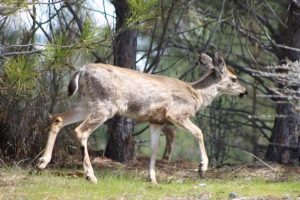I was driving to work recently, feeling disappointed about my gardening failures this past year, when a segment on National Public Radio lifted my spirits. A scientist was talking about how most of his colleagues actually embrace failure because it always offers new data and, most importantly, raises new questions (and what is a scientist if not someone who always wants to know Why?).
It occurred to me that that attitude toward failure is a great mindset for gardeners, because let’s face it, pests happen, plants die and, one way or another, Mother Nature always seems to have the final say. Better to accept the fact that gardening is a trial and error undertaking. Best to focus on what you can learn from this year’s disappointing bounty or another year’s curious blight.
Here are a few gardening failures I learned from this year: Deer-proof plants. I live on a third of an acre that is largely unfenced. My attempts to protect veggies and ornamentals from the adorable deer that frequent my yard were marginal at best. Liquid Fence? Sure, it works for a few weeks, until the deer catch on and munch away anyway. Wire cages? Yes, if you anchor them down as if you were expecting a tornado (or a big buck’s insistent nose), and if you NEVER forget to put them back on after tending to the plant underneath. And, as for “deer-resistant” plants, my experience is that there are maybe two: the toxic foxglove and some iris. If deer are hungry, they will eat almost anything.
Lesson: In my neighborhood, you really, really need to have a solid eight-foot fence if you want to keep the deer from decimating the plants in your garden.
“Natives” aren’t always foolproof. For one thing, many gardening books and online sources define native plants broadly as those that are indigenous to the U.S. The problem is that a plant that is native to the Florida wetlands, the humid-summer Midwest or the cool-summer, foggy California coast is probably going to fail miserably in the Mother Lode.
Lesson: To reduce gardening failures, choose plants that are native to the foothills or areas with similar growing conditions.
Don’t rely on nursery plant tags. The labels that accompany nursery plants, especially at big-box stores, are often very nonspecific (“sun to part shade”). My guess is that those overly generalized tags are simply a cost-effective way to stay in some vague, safe range of growing advice for vast inventories of plants. I have tried and failed more times than I can count when trusting plant tags that don’t address the specifics of my locale.
Lesson: If you aren’t familiar with a plant’s ideal growing conditions, look it up first in Sunset’s Western Garden Book or the UC Extension website at www.ucanr.edu (there is a search area to enter what plant you are researching) before buying it.
Most beautiful gardens are the result of trial and error. To reduce your chance of failures, read up on plants before you buy them. Knowing your landscape and its microclimate will boost your chances of a successful garden.
Rachel Oppedahl is a University of California Cooperative Extension Master Gardener of Tuolumne County who hopes never to stop learning in the garden.


